Kanji for “Live,” “Be Born,” “Raw”: 生
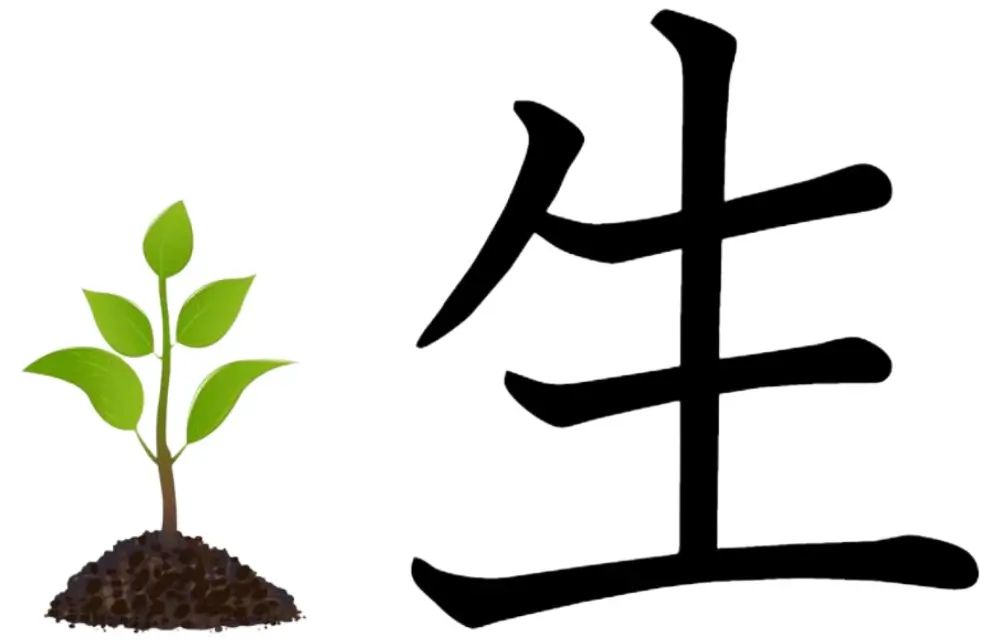
The Japanese kanji 生 means Kanji for “Live (life),” “Be Born,” “Raw.”
The kun’yomi (Japanese reading) pronunciation of the Kanji 生 is u (う), as in the words umu (うむ) and umareru (うまれる); o (お) as in ou (おう); ha (は), as in hayasu (はやす) and ha-eru (は-える); i (い) as in ikeru (いける), ikiru (いきる) and ikasu (いかす); nama (なま); and ki (き).
The on’yomi (Chinese reading) pronunciation of 生 is sei (セイ) or sho (ショウ).
The meaning of the Kanji 生 extends to the following:
- Life, Alive: It primarily denotes life or being alive.
- Birth: It is used to indicate birth or the act of being born.
- Raw: In terms of food, 生 can describe something that is raw or uncooked.
- Pure: It can also express purity or a natural state of being.
- Grow: 生 is used to talk about growth or the process of growing.
- Student: In compounded words such as 学生 (がくせい / gakusei), it means “student,” denoting someone who is at the stage of life where they are learning.
- Live: It can also refer to something that is live, as in a live broadcast (生放送 / なまほうそう / namahōsō).
後 quite commonly appears in Japanese names and is used in 4372 names. However, in names, it is pronounced as Asa (あさ), iki (いき), iku (いく), ike (いけ), ubu (うぶ), umai (うまい), e (え), oi (おい), gyū (ぎゅう), kurumi (くるみ), gose (ごせ), sa (さ), jyō (じょう), sugi (すぎ), so (そ), sō (そう), chiru (ちる), naba (なば), niu (にう), niū (にゅう), fumi (ふ み), mō (もう), yoi (よい), ryū (り ゅう).
The Kanji 後 is constructed with 5 strokes. It is part of the JLPT N5 syllabus (please check the list of JLPT N5 Kanji). In Japanese schools, this Kanji is taught in grade 1.
Origin of the Shape 生
In a way, we can say that the origin of the shape of the Kanji 生 was quite poetic. What can better represent life, or coming to life by being born, or even raw or crude because of being just born other than a sprouting of a plant?
If we see the ancient shape (kyūjitai) of the Kanji 生, it shows a small plant coming out of the soil or a sprout. However, the original shape was very easy to confuse with the Kanji for earth or soil. So, like most other Kanji characters, the shape evolved to the modern shape, or “shinjitai” as 生
Let’s see the evolution of the shape of the Kanji 生 from ancient times to the current:
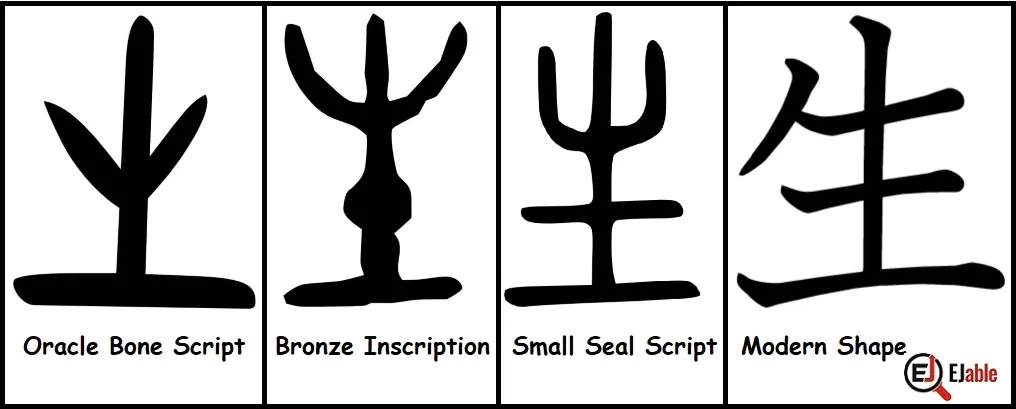
As shown in the above illustrations in the Oracle Bone Script the Kanji meaning to be born, or coming to life, or raw showed a small plant sprouting out of the soil. Later, in the Bronze inscription, a small horizontal dash appeared on the stem, which grew larger in the small seal script.
The reason was probably that a small sprout with two leaves or branches would mean birth, more specifically, but might not capture the meaning of life as such. The added horizontal line may mean emphasis, but on the other hand, it can be seen as adding two more branches.
The addition of two more branches shows the growth of the plant, extending this kanji’s meaning to signify life, along with birth. This addition also makes the early shape of this Kanji distinctly different from the Kanji of earth (土).
The modern shape (shinjitai) is a simplified form of the ancient shape, with a dash added to the top left-hand branch.
Mnemonic to Remember the Kanji 生 Meaning “Life”
The above-mentioned logic serves as a great way to remember the meaning of the Kanji 生 as living, to be born, and further extending the meaning as “raw” because a person can be considered as raw immediately after birth or before growing up.
However, to make it easier, the following illustration can serve as a mnemonic to remember the Kanji 生 for its meanings mentioned above:
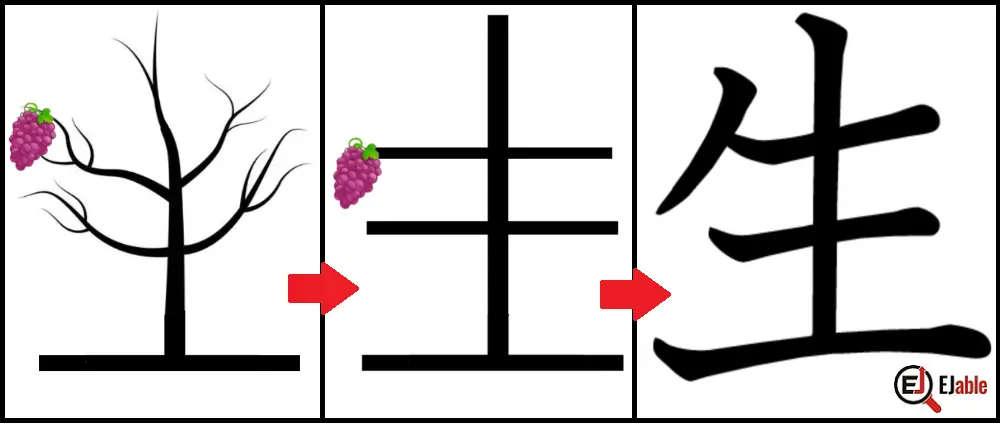
In the above illustration, you can consider the dash on the top-left branch of a tree as a fruit, depicting birth or new life.
Stroke Order for the Kanji 生
The following illustrations show the order of the 5 strokes to write the Kanji 生:
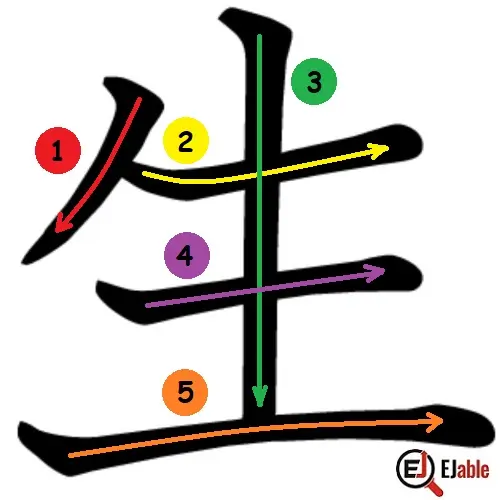
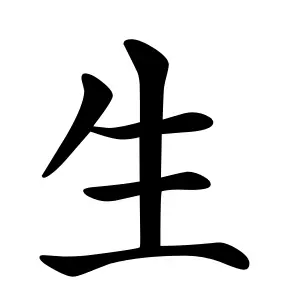
生 as a Component in other Kanji Characters
The Kanji 生 is used as a component in 51 Kanji characters, out of which 7 are Jōyō (commonly used) Kanji.
In these other Kanji characters, 生 conveys a range of life-related concepts. These extend from physical existence and natural qualities to ideas like growth, production, and awakening.
Examples of 生 as a Radical or Component in Jōyō Kanji
Following are the 7 some Jōyō kanji where 生 (life) appears as a Kanji radical or component:
- 性 (せい / sei): Nature, character, sex/gender.
- Explanation: This Kanji combines 生 with the radical for 心 (heart), indicating traits or qualities that are inherent or natural to a person, often related to one’s disposition or gender.
- 産 (さん / san): Produce, give birth, yield.
- Explanation: Historically, this Kanji was a combination of the Kanji meaning to be born or life (modern shape 生), “cliff” radical (厂), and 文 meaning sentence or literature. The combination of 生 and 厂 can be considered as the forehead of emerging life or radically as an incline or foundational support for the emerging life. The kanji 文 can be considered as art or design, symbolically representing the structured or designed aspect of what is produced, whether it’s a new life or manufactured goods. Together in 産 they represent products or outcomes that are born or produced, often used in the context of childbirth or manufacturing.
- 星 (せい / sei, ほし / hoshi): Star.
- Explanation: This character merges 生 with 日 (sun), suggesting a celestial body like a star, which is perceived as a point of light similar to the sun.
- 姓 (せい / sei): Surname.
- Explanation: Combines 女 (woman) with 生, referring to family lineage or names that are passed down through generations, often related to familial connections and heritage.
- 隆 (りゅう / ryū): Prosperity, growth.
- Explanation: The Kanji 隆 consists of 生 (“life” or “birth”), 夂 (“go” or “walking slowly,” suggesting movement or progress), and 阝 (“hill” or “village” radical). Here, 生 represents life or growth, 夂 implies gradual progress or moving forward, and, when used in 隆, signifies the idea of an area or territory, contributing to the overall meaning of expansion or elevation associated with prospering or rising.
- 牲 (せい / sei): Sacrifice, victim.
- Explanation: Combines 生 with 牛 (cow), referring to animals used for sacrificial purposes or metaphorically to sacrifices made for the greater good or a cause.
- 醒 (せい / sei): Awake, sober up.
- Explanation: This Kanji includes 生 and 酉 (wine vessel), which indicates awakening or becoming sober. It is often used metaphorically to suggest coming to one’s senses or becoming alert.
生 Kanji in Compounded Words
There are 616 Japanese words that begin with the Kanji for “Live” or Life, “raw,” or “be born” (生), and it appears in 1526 words overall.
Examples of Kanji 生 in Compounded Japanese Words
- 生活 (せいかつ / seikatsu): Life, living— everyday activities and existence.
- 生命 (せいめい / seimei): Life— refers to biological life or existence.
- 一生懸命 (いっしょうけんめい / isshōkenmei): With all one’s life— putting forth one’s utmost effort.
- 生年月日 (せいねんがっぴ / seinen’gappi): Date of birth— the exact day one was born.
- 生徒 (せいと / seito): Student— a person who is at a stage of life where they are learning.
- 生物 (せいぶつ / seibutsu): Living thing— any organism that has life.
- 生産 (せいさん / seisān): Production— the act of producing goods, often used in manufacturing contexts.
- 新生活 (しんせいかつ / shinseikatsu)— New life; starting a new phase in life, typically after a major change.
- 人生 (じんせい / jinsei): Human life— a person’s life or existence.
- 生きがい (いきがい / ikigai): Reason for living— something that gives one a purpose in life.
- 生中継 (なまちゅうけい / namachūkei): Live broadcast; a television or radio broadcast conducted in real time.
- 生きる (いきる / ikiru): To live— the act of living or existing.
- 生まれる (うまれる / umareru): To be born— the act of coming into life.
- 生ビール (なまびーる / nama-bīru): Draft beer; beer served directly from a keg or cask.
- 生涯 (しょうがい / shōgai): Lifetime— the duration of a person’s life.
- 生物学 (せいぶつがく / seibutsugaku): Biology— the scientific study of life.
- 日常生活 (にちじょうせいかつ / nichijōseikatsu): Daily life— everyday routine or existence.
- 出生率 (しゅっしょうりつ / shusshōritsu): Birth rate— the rate at which births occur in a population.
- 野生 (やせい / yasei): Wild— refers to animals or plants living in natural conditions without human intervention.
- 生理 (せいり / seiri): Physiology or menstrual cycle— biological processes or the monthly cycle in women.
These compound words demonstrate how 生 is used in various contexts, reflecting its fundamental meaning of life, existence, and natural or raw states.
Note: Check other Kanji characters on the page “How to Learn Kanji“.

A long-term ex-pat in Japan, Himanshu comes with an IT background in SAP consulting, IT Business Development, and then running the country operations of an IT consulting multinational. Himanshu is the co-founder and Managing Director of ReachExt K.K. and EJable.com. He is also an Advisory Board Member of a Silicon Valley AI/IoT startup.
